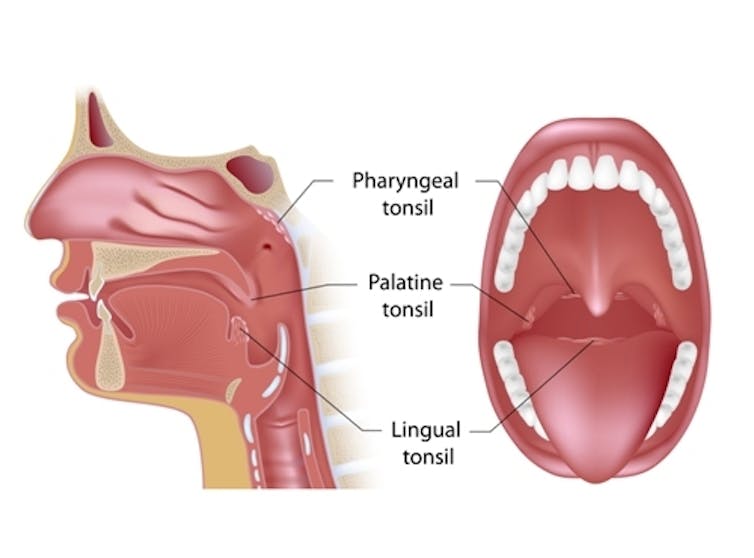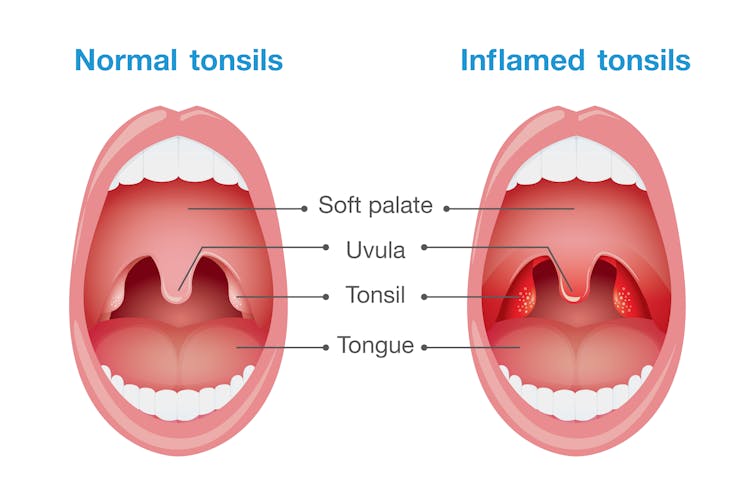 If they are simply too large, your tonsils can be shrunk down using special instruments which remove the valleys and cryptsShutterstock
If they are simply too large, your tonsils can be shrunk down using special instruments which remove the valleys and cryptsShutterstockThis is an article from Curious Kids, a series for children. The Conversation is asking kids to send in questions they’d like an expert to answer. You might also like the podcast Imagine This, a co-production between ABC KIDS listen and The Conversation, based on Curious Kids.
Why do we have tonsils????? – Ryan, age 10, Blacktown.
Thanks Ryan. I am guessing, based on the number of question marks you’ve used, that your tonsils might have caused you some trouble. You’re not alone.
The truth is that unless you are a baby, you don’t really need tonsils. Many people have them removed and live happily without them. I’ll tell you why, but first I have to explain what your tonsils actually are.
Waldeyer’s ring
The technical term for your tonsils is “palatine tonsils”, which means the tonsils of the palate. These lumpy things sit on either side at the back of our mouths. The palatine tonsils are one pair of a set of four tonsils that form a circle at the top of our throat.
At the back of our nose, we have the adenoids. They are another type of tonsil tissue, technically called the “nasopharyngeal tonsils”. There is also a blanket of tonsil tissue over the back of our tongue called the “lingual tonsils”, which we can’t normally see. The adenoids and the tonsils are linked by a thin strip of tonsil tissue on each side; these are called the “tubal tonsils”. Together this whole ring of tonsil tissue is called “Waldeyer’s ring”, named after a nineteenth century German anatomist.
 The palatine tonsils are one pair of a set of tonsils that form a circle at the top of our throat.Shutterstock
The palatine tonsils are one pair of a set of tonsils that form a circle at the top of our throat.ShutterstockRead more: Curious Kids: Do sharks sneeze?
Tonsils are important for immune defence
Waldeyer’s ring forms part of our immune system, along with our lymph glands (which are either side of your neck).
In early life, the lymph glands are not completely developed, and our bodies rely on our tonsils to trap bugs and foreign material that we either breathe in or swallow. By trapping these particles, the body begins to recognise them as potentially dangerous things and produces things called antibodies to kill them so they can’t harm us. Tonsil tissue is particularly good at trapping these particles as it has valleys and holes (called crypts) which increase its surface area.
Tonsil tissue is particularly important in the first six months of life. After this, our lymph glands take over most of the work and the tonsils are essentially out of a job.
Tonsil trouble
As we get older, food and germs can still land in the valleys and crypts. They can then cause infections to develop, which lead to a sore throat or tonsillitis. Some infections can also cause the tonsils to grow in size. Huge tonsils and adenoids can block the airway and cause snoring or swallowing and speech problems. As nutrition and immunisation has improved, kids get tonsillitis less and less these days. Usually, an ear nose and throat surgeon like me gets called in to intervene more for obstruction (blockage) than repeated infections.
 Comparison between normal tonsils and inflamed tonsils.Shutterstock
Comparison between normal tonsils and inflamed tonsils.ShutterstockRead more: Curious Kids: I heard that breathing through your mouth makes your IQ go down. Is that true?
Shrinking tonsils
If tonsils are a problem, an ear, nose and throat surgeon can remove them by doing an operation. If they are simply too large, they can be shrunk down using special instruments which remove the valleys and crypts. This leaves a thin bit of tonsil tissue behind.
Shrinking the tonsils down reduces the amount of pain kids get and also reduces the chances of bleeding after the operation. The downside is that, in rare cases, the bit we leave behind can get infected, or can regrow - although this is uncommon.
People sometimes worry that by removing the tonsils, we may be more likely to get infections. This is not actually the case. The lymph glands take over the role of protecting us.
If tonsils are too big or keep getting infected, they end up being more trouble than they’re worth.
Hello, curious kids! Have you got a question you’d like an expert to answer? Ask an adult to send your question to us. They can:
* Email your question to curiouskids@theconversation.edu.au * Tell us on Twitter
 CC BY-ND
CC BY-NDPlease tell us your name, age and which city you live in. You can send an audio recording of your question too, if you want. Send as many questions as you like! We won’t be able to answer every question but we will do our best.
Simon Carney also works in private practice, is a consultant for Johnston & Johnston, Olympus and has received funding from the NHMRC.
Authors: Simon Carney, Professor of Otolaryngology - Head & Neck Surgery, Flinders University
Read more http://theconversation.com/curious-kids-why-do-we-have-tonsils-98771
| < Prev | Next > |
|---|







